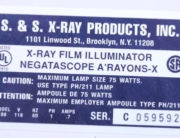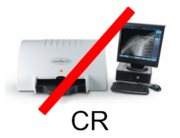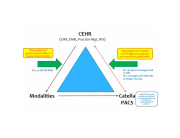I know you might think I’m milking the reimbursement issue for as many blogs as possible, but unless something more comes to light this is my last blog on this issue. (I’m looking at the OEM vs. ISO issue that the FDA is asking for comments about…seems like another attempt to cut out the independent business …but that’s the next blog.)
NOW BACK TO CR VS. DR
Since I last wrote I’ve done some research. I was able to get a list of typical x-ray studies. Below is a chart that sets forth what I believe are the current  technical reimbursement rates and the reductions that will be imposed on CR assuming the rates stay the same over the next few years. I also have included film in the chart as it is relevant for the second half of this blog.
technical reimbursement rates and the reductions that will be imposed on CR assuming the rates stay the same over the next few years. I also have included film in the chart as it is relevant for the second half of this blog.
| CPT Code | Study of: | Technical Rate | 7% CR Reduction | 20% Film Reduction |
| 73030 | Shoulder | $35.80 | $2.51 | $7.16 |
| 73111 | Wrist | $35.80 | $2.51 | $7.16 |
| 74000 | Abdoman | $35.80 | $2.51 | $7.16 |
| 71111 | Ribs/Chest | $35.80 | $2.51 | $7.16 |
Since these studies have the same reimbursement, it makes the chart below of “breakeven” years (assuming various numbers of total studies per year) easy to calculate. These are different numbers than the last blog, but the bottom line is that small practices should not discount CR as a viable option because of this ridiculous new law.
| Annual Studies | Reduction in Reimbursement Because Using CR | DR Upgrade Breakeven Point in Years** |
| 1,000 | $2,510 | 15 years 10 months |
| 2,500 | $6,275 | 6 years 4 months |
| 5,000 | $12,550 | 3 years 2 months |
| 10,000 | $25,100 | 1 years 9 months |
| 25,000 | $62,750 | 7 months |
** One dealer estimated that with service and drop insurance added, the cost of a DR upgrade could be as much as $40,000 even when the CR “trade in” value was considered. If you think that is too high or too low, change it. Also you might add in “tax savings” due to new equipment depreciation although I think of this as false savings. (I’d rather have the money in my pocket.) All years are rounded down to the nearest month.
NOW LET’S LOOK AT FILM
 As I mentioned in earlier blogs I agree that film should go the way of all flesh. One of my mentors, Art Quint (hired by George Picker in 1938!) would slap me for saying this because he always argued that a really well taken x-ray with its continuing tones versus digital pixels is always better. But Art, who worked for me after he sold his business and was still writing orders at 90, had to admit that most practices, including large hospitals, never did the quality control necessary to produce that perfect film x-ray.
As I mentioned in earlier blogs I agree that film should go the way of all flesh. One of my mentors, Art Quint (hired by George Picker in 1938!) would slap me for saying this because he always argued that a really well taken x-ray with its continuing tones versus digital pixels is always better. But Art, who worked for me after he sold his business and was still writing orders at 90, had to admit that most practices, including large hospitals, never did the quality control necessary to produce that perfect film x-ray.
Over the years, digital technology has improved in both the resolution that can be obtained and the the image quality that can be achieved through software optimization. Now there are models of CR and DR that I believe even Art would agree produce a better patient care experience than film. He would list the reasons as:
- Workflow – how quickly an image can be generated.
- Elimination of steps – no more darkrooms and all the time that should be taken to maintain quality control.
- Medical Records Integration – Now, with little effort, x-ray can be added to the patient’s electronic medical record and be easily accessed by all medical care professionals.
- Adding Advanced Technology – Whether it is as simple as window/level or as advanced as computer- aided diagnosis, digital images offer more possibilities for better care.
- Environmental – Elimination of chemicals and heavy metals, as well as reduced use of petrochemicals to make the film and emulsions. Art loved his big Caddie, but generally he was “green”.
But there are other reasons to move away from film. Let’s look at the cost side.
For the chart below, I’ve polled a number of x-ray dealers for “retail” cost information for new and pre-owned CR systems. (None of them could offer me estimates of pre-owned DR systems as there are relatively few available today.)
Another option several dealers suggested was “renting” pre-owned CR systems. Here the customer would pay a monthly fee and the dealer would provide whatever he had. This is an idea I have been pushing as well to dealers since I’m in the business of selling them pre-owned equipment.
I’ve heard of monthly rental prices of $350 to $500, depending on the type of system used. Again polling dealers, they suggested that this is the average amount a typical small practice would spend per month on film, chemistry and maintenance.
Below is a chart that puts together these variables:
| Number of Studies/Month | Breakeven if buying Pre-owned CR*** | Monthly Net Cost or “profit” if renting a pre-owned CR**** |
| 50 | 4 years 6 months | Net cost is $233.75 |
| 100 | 2 years 9 months | Net profit is $115.00 |
| 150 | 1 years 9 months | Net profit is $347.50 |
*** Note: the average cost of a pre-owned system is between $10,000 and $15,000, according to my informal poll. I used an average cost of $12,500. From the reimbursement charge above, using CR reduces the reimbursement reduction from $7.16 to $2.51; this is a “savings” of $4.65 per study.
**** I used the lower monthly rental cost of $350 for this column. This cost/profit figure was calculated as $350 less the higher amount of reimbursement paid for using CR over film (times the number of studies)
As you can see moving from film to CR is a “no brainer.”
 But, as my good friend and x-ray dealer, Joseph Eliafan, adds “there is more!” As the use of film continues its steep decline, the cost of film, chemistry and service is going to rise. In the past several years, we have seen a consolidation of chemistry producers and film companies are reducing the range of films. In addition, many dealers are not holding significant inventories, so the ability to get same day delivery in some areas has vanished. All of these factors, reduced volume, limited number of producers and smaller inventories mean that prices will increase. This makes the “breakeven” times listed above even smaller.
But, as my good friend and x-ray dealer, Joseph Eliafan, adds “there is more!” As the use of film continues its steep decline, the cost of film, chemistry and service is going to rise. In the past several years, we have seen a consolidation of chemistry producers and film companies are reducing the range of films. In addition, many dealers are not holding significant inventories, so the ability to get same day delivery in some areas has vanished. All of these factors, reduced volume, limited number of producers and smaller inventories mean that prices will increase. This makes the “breakeven” times listed above even smaller.
Joseph also suggests that regulations may get tougher and more costly. Here’s one story that might support this theory. For years, AMD sold sensitometers and densitometers made by my good friend Klaus Schwuchow of Pehamed. Those sales dropped off about ten years ago as CR and then DR were introduced. In the last two years we have sold more of these “Densonorm” products than we had sold in the previous ten years combined! When I placed my third large stocking order in 2014, Klaus called me up to ask why Americans were moving backwards.
The answer is regulations. In several states, California being one of them, health regulators are out in force examining all practices using x-ray. One of the things they are looking to find is the quality control program for developing film x-ray. It will be little surprise to you that many practices have no QC system or even know that they need one. The choices these practices face are: 1) close their x-ray practice, 2) implement a film QC program or 3) go digital. To have a film QC practice, they need a Densonorm or similar product. 
Many practices are taking a hard look at the reason they have x-ray. Is it for patient convenience/care and/or for profitability? Others who wish to maintain their x-ray services have to make the decision of film vs. digital. Those staying with film are making that decision primarily based on cost. Spending a few thousand dollars to implement a QC practice is far cheaper than going digital, particularly if the volume is low or the doctors don’t believe they will be in practice much longer.
So I think Joseph makes a good point that the cost of increased current and future regulations is adding to the cost of maintaining a film-based x-ray practice.
 Societal pressure to “move green” will only increase. It is already influencing our state regulators. As a rule, states want heavy metals out of our landfills and our sewer systems. As cities move to gray water systems or burning solid waste for electrical generation, the pressures will only increase to make the source materials as clean as possible. Dropping off your old film and used chemicals could involve taking them personally to drop off points like we now do for household chemicals and paints. However, since x-rays are generated by businesses, it is not inconceivable that at some pointthe recycling of film and chemistry will required payment of a hazardous waste fee.
Societal pressure to “move green” will only increase. It is already influencing our state regulators. As a rule, states want heavy metals out of our landfills and our sewer systems. As cities move to gray water systems or burning solid waste for electrical generation, the pressures will only increase to make the source materials as clean as possible. Dropping off your old film and used chemicals could involve taking them personally to drop off points like we now do for household chemicals and paints. However, since x-rays are generated by businesses, it is not inconceivable that at some pointthe recycling of film and chemistry will required payment of a hazardous waste fee.
So there you have it. Over the last several blogs I have explored this change in film and digital x-ray reimbursement rates. I hope I have helped both dealers and their clients understand the new law and given you tools to decide what is best for you to do. I also hope that I have shown you that moving to or staying with CR may be the right decision for many clients. And I hope that our dealer friends will help me find a way to keep those good pre-owned CR systems out of our landfills.
As always, I welcome your comments.








Nice work Dan. These articals are very informative and useful for closing the deal.
Great information!!!
I learn a lot with this article.
Best, Raul G
Blasphemer! I’m campaigning to Make X-Ray Film Again.
Jim
(Note Jim is one of the last surviving master distributors of film processors. Editor’s note: Just sour grapes!)
Dan,
One major major advantage of digital images over film is that since a typical high-quality chest X-ray image has a file size of around 20 MB, 100,000 chest studies would take about 4,000,000 MB (3.8 TB) of storage, which can be saved in a small external hard drive, about the size of a book. The images can be accessed with the click of a mouse, and clinicians can view them immediately and simultaneously at multiple locations, and they never get lost (or borrowed by medical students, interns, residents, etc., etc.).
Those same 100,000 chest studies on film would take up a large room, require staff to sort them, file them, check them in, check them out, and track them when they go missing.
And while you do mention work flow, from the Technologists perspective, the advantage is the ability to complete the study in essentially the time that it takes to position the patient and make the exposure (around 30 seconds), vs. changing the cassette (assuming that you didn’t have an automatic film changer), and waiting for the film to process (90 seconds). Even if you had a film processor attached to the back of the film changer, which became available in the mid 1970s, you still had to check the film (vs. looking at it on the monitor), place it in an envelope, and file it.
And for those who remember those fabulous parties that were given by the film companies at the RSNA, while we miss the parties (we REALLY do miss those parties!!!), we do not miss the dark room.
Gregory H
(Editor’s note: Yes the parties! I do remember them. That’s when it was really fun to go to a trade show. Can you imagine how much money those film companies where making in those long gone days? Kodak did such a good job keeping their hands on those profits!)
Dan,
Thanks for the update .
Al DiLanzo